Best of India Tours
- Golden Triangle Tour- Best of India & Nepal
- Classical Rajasthan
India Cultural Tours
- Images of North India- Karnataka Heritage
- Rajasthan & Goa Tour
Discover India Tours
- Grand India Tour- North to South India
- Central to South India
Rajasthan Tours
- Classical Rajasthan Tour- Golden Triangle Tour
- Grand Mughal Tour
India Luxury Trains
- Palace on Wheels- The Golden Chariot
- India Deccan Odyssey
- The Indian Maharaja
- Royal Rajasthan on Wheels
Nepal Tours
- Glimpses of Nepal- Buddhist Pilgrimage
- Nepal River Rafting
- Destinations of Nepal
- Nepal General Info
India Wildlife Tours
- North India Wild Life- South India Wildlife
Tibet Tours
- Tibet Monastery Tours- Explore Tibet
- Destinations of Tibet
Spa & Yoga Tours
- Ananda in Himalayas- Yoga & Meditation
Adventure Tours
- Manali Safari Tour- Himalayan Trekking
- Horse Safari
Delhi

Delhi is a city that defies a one-line description as the capital of India or as the capital of the world’s largest democracy. Actually, Delhi is India in miniature. Delhi is 32,87,263 sq. km of India’s fantastic variety compressed into 1483 sq. km Over the millennia, it has wooed rulers, attracted plunderers, and tried historians with so many details. Today, even as it preserves an enviable heritage, Delhi is a true cosmopolitan city always on the move.
Delhi remains the centre of power. Once it was a city of royal power. Then it became the seat of colonial power. Later it was the seat of bureaucratic power. The seat of political power it has always been. Today it is emerging as an important centre for corporate power too. However, the most fascinating aspect of this city is its cosmopolitan nature.
Sightseeing
Delhi is an international metropolis with excellent tourist spots, recreational facilities, and a history that goes back to antiquity. A remarkable feature of the city is the extent of greenery all over. Delhi is also a dream city for vistors looking for items of handicrafts, not only the rich artistic crafts of its own craftsmen but also of craftsmen from all over the country. Delhi offers a multitude of interesting places and attractions to the visitor, so much so that it becomes difficult to decide from where to begin exploring the city. In Old Delhi, you’ll come across many mosques, forts, and other monuments that depict India’s Muslim history. The important places in Old Delhi includes the Red Fort, Jama Masjid, Chandni Chowk, Delhi Gate, and Raj Ghat and Shanti Vana, the last two being modern structures constructed after India’s Independence in 1947. New Delhi, on the other hand, is a modern city designed by Edwin Lutyens and Herbert Baker. It is a spacious, open city that houses many government buildings and embassies, besides places of historical interest. Notable attractions in New Delhi include the Rashtrapati Bhawan, India Gate, Laxminarayan Temple, Humayun’s Tomb, Purana Quila, Tughlaqabad, Qutab Minar, and Bahai Temple.
Excursions
Many wildlife sanctuaries, heritage sites, hill stations, and quaint little towns surround Delhi. Haryana, which encloses Delhi on three sides, is ideal for quick getaways as most of its tourist spots are quite close. The Sultanpur Bird Sanctuary and Tilayar, Surajkund, and Badhkal lakes are only a few of the plethora of attractions that Haryana has to offer. Move over to the nearby places of Rajasthan like Neemrana and Kesroli and you are sure to have a wonderful time amidst nature—if only for a weekend. Escape to the Mud Fort at Kuchesar in Uttar Pradesh and let the cool air and scenic beauty revive your spirit.
Excursions for Delhi
India Gate
India Gate is a memorial raised in honour of the Indian soldiers martyred during the Afghan war. The green, velvety lawns at India Gate, particularly, are a popular evening and holiday rendezvous for young and old alike. Ice-cream carts, balloon wallahs, popcorn and peanut vendors, carts selling cold water and cold drinks, panwallahs, men and women selling sweet-scented jasmine gajras (garlands) to decorate a bride, wife, daughter or girlfriend/’s hair, do brisk business at the fringe of the lawns.

Rashtrapati Bhawan
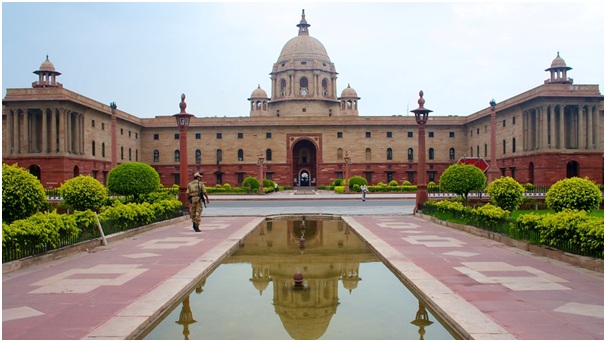
Modern Delhi, or New Delhi as it is called, centres around the Rashtrapati Bhawan. It is architecturally a very impressive building standing at a height, flowing down as it were to India Gate. This stretch called the Rajpath is where the Republic Day parade is held. The imposing plan of this area conceived by Lutyens does not fade in its charm with the numerous summers or winters that go past.
Rashtrapati Bhawan was once the imperial residence of the British viceroys.
Built on the Raisina hills of Delhi ridge, this 340-roomed structure has an imposing character overlooking India Gate and Rajpath. It is now the official residence of the president of India.
For lovers of flowers and beauty, the annual spring opening of the glorious, meticulously tended Mughal Gardens at the stately Rashtrapati Bhawan is a bonanza topped by an amazing assembly of roses in perfect bloom—perhaps the best in the whole of India.
Laxminarayan Temple
Also called the Birla temple, the Laxminarayan Temple was built by the Birla family in 1938. It is a temple with a large garden and fountains behind it. The temple attracts thousands of devotees on Janmashtami day, the birthday of Lord Krishna. The Father of the Nation, Mahatma Gandhi, was assassinated in this temple complex in 1948.
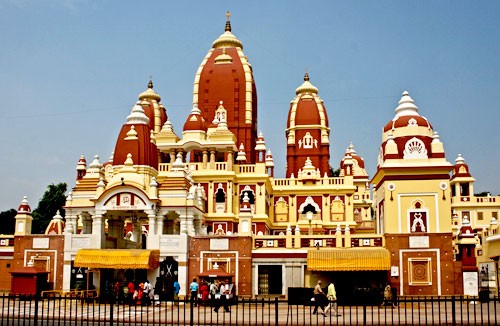
Humayun’s Tomb (Delhi)
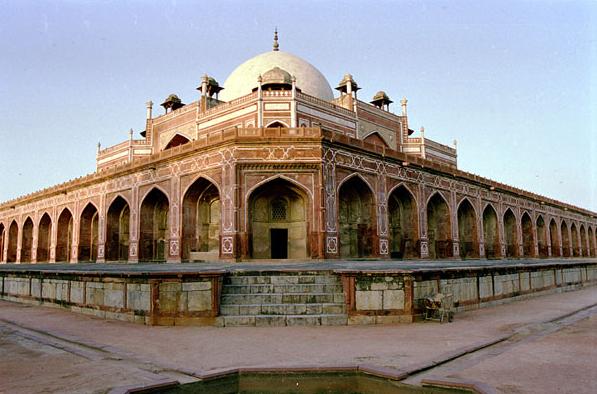
Humayun’s Tomb was built nine years after Humayun’s death by his wife Haji Begum. Designed by a Persian architect named Mirak Mirza Ghujas, and completed in 1565, the edifice was a trendsetter of the time. It is said that all later Mughal monuments, including the Taj Mahal, followed its design.
Qutub Minar
The Qutab Minar is located at a small village called Mehrauli in South Delhi. It was built by Qutub-ud-din Aibek of the Slave Dynasty, who took possession of Delhi in 1206. It is a fluted red sandstone tower, which tapers up to a height of 72.5 m and is covered with intricate carvings and verses from the holy Quran. Qutub-ud-din Aibak began constructing this victory tower as a sign of Muslim domination of Delhi and as a minaret for the Muslim priest, the muezzin, to call the faithful to prayer. However, only the first storey was completed by Qutb-ud-din. The other storeys were built by his successor Iltutmish. The two circular storeys in white marble were built by Ferozshah Tughlaq in 1368, replacing the original fourth storey.
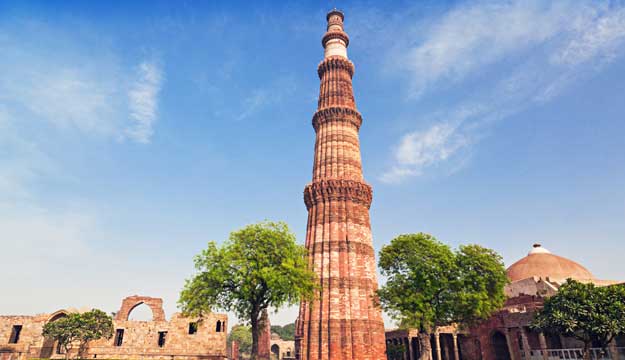
The projected balconies in the tower are supported by exquisite stalactite designs. The tapering tower has pointed and circular flutings on the first story round and star-shaped on the second and third stories. The bands of calligraphic inscriptions are amazing in perfection with the exquisite stalactite designs seen on the exterior of this tower.
The Qutab Minar, apart from being a marvel in itself, is also significant for what it represents in the history of Indian culture. In many ways, the Qutab Minar, the first monument of Muslim rule in India, heralded the beginning of a new style of art and architecture that came to be known as the Indo-Islamic style.
Red Fort

When one approaches old Delhi with a somewhat Westernized perception the emotional response can range from wonderment to bewilderment, from utter disgust to ecstasy. Undoubtedly, Old Delhi gives an insight into the multi-layered identity that so aptly characterizes India. The lanes are narrow, filled to bursting with people, throbbing with life. In the midst of this sea of people, suddenly you come face to face with the ramparts of the Red Fort. The decision for constructing the fort was taken in 1639, when Shahjahan decided to shift his capital to Delhi. Within eight years,
Shahjahanabad was completed with the Red Fort—Qila-i-Mubarak (fortunate citadel)—Delhi’s seventh fort, ready in all its magnificence to receive the Emperor. Though much has changed now because of large-scale demolitions during the British occupation of the fort, its important structures have survived the glory faded with age but still impressive. Passing under the grand Gothic arch and the octagonal open space of the market place—the Chatta Chowk, and the Naubat Khana—a double-storeyed structure where court musicians played five times a day, we see Diwan-i-Aam. Here is the fabulously crafted baldachino—the marble canopy decorated with the most exquisite pietra dura work. Diwan-i-Aam witnessed scenes of unexcelled splendour when it used to be decorated with golden curtains, gorgeous carpets, and gold and silver railings below dazzling chandeliers. Ministers, Rajas, and ambassadors stood in mute awe of the Emperor in court.
Behind the Diwan-i-Aam are the Zenana quarters with such grand palaces as the Rang Mahal and Mumtaz Mahal. The marble lotus, a fountain in the centre of Rang Mahal, carved out of a single slab, is a piece of sheer beauty. In its sculptured grandeur, the lotus is matched only by the trellis wall under the scales of justice in the Khwab Gah. The pavilion in white marble—Diwan-i-Khas—has lost much of its splendour. Here, under the original silver ceiling, stood the world famous Peacock Throne studded with the costliest gems of the Mughal Empire, costing nearly 12,637,500 sterlings as per a contemporary account. On the ceiling slab is inscribed the line, if there is a paradise on the face of the earth, it is here, it is here, it is here’. Nadir Shah, Ahmad Shah Abdali, Ghulam Qadir, the Marathas, and finally the British looted and plundered the Mughal treasures and destroyed many structures of immense beauty. Still the Shah Burjan octagonal tower at the corner, and the two marble pavilions, Sawan and Bhadon, named after the Indian months of rain, have withstood forces of destruction. The gardens—Mahtab Bagh and Hayat Baksh—have vanished. A later-day pavilion in red sandstone stands at the centre of a dried up pool. It was built by Bahadur Shah II. Moti Masjid, the mosque built by Aurangzeb, is a gem of architecture despite the sickly marble of the new domes—original copper casing having been removed long back.
The Red Fort still retains some of its lost glory. It is the only fort with some well-preserved royal structures to give an idea of the glory of the Mughal Empire. The Red Fort was the last fort built in Delhi and it witnessed the vicissitudes of fortune, the splendor and the fall of the Mughals, British rule, and finally the dawn of Indian Independence
Chandni Chowk
The living legacy of Delhi is Shahjahanabad. Created by the builder of Taj Mahal, this city, with the Red Fort as the focal point and Jama Masjid as the praying centre, has a fascinating market planned to shine under the light of the moon, called Chandni Chowk. Shahjahan planned Chandni Chowk so that his daughter could shop for all that she wanted. It was divided by canals filled with water, which glistened like silver in moonlight. The canals are now closed, but Chandni Chowk remains Asia/’s largest wholesale market. Crafts once patronized by the Mughals continue to flourish in the small lanes of the city.
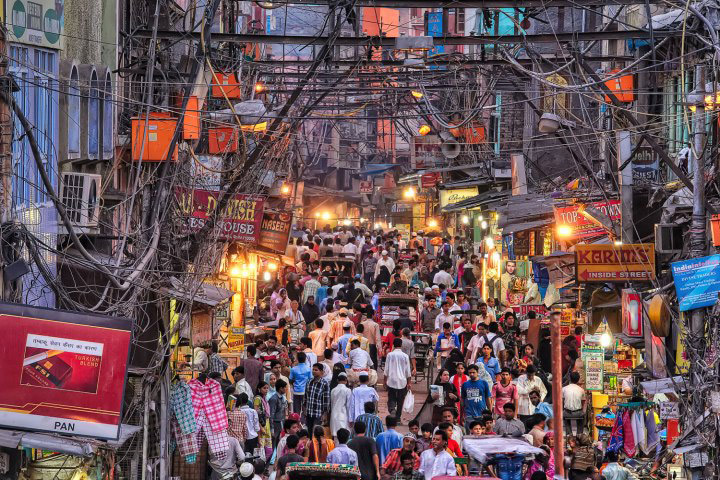
Tradition and modernity meet at unexpected places in Shahjahanabad. If you see a man pulling a rickshaw or feeding pigeons, you will see just as many talking over the cello or assembling a computer! An experience of timelessness awaits you at Shahjahanabad. The by lanes of Chandni Chowk have been named after the specialty items that are available here. For instance, if you need a break go to Parantha Wali Gali for a delicious lunch of the most crisp and light-stuffed paranthas. The eateries here have been in operation for over 100 years!
Stroll through the lanes and by lanes of Chandni Chowk and you will find everything under the sun—wholesale items ranging from hair dryers to spare parts of a BMW. The most interesting street in this area is Dariba Kalan where all jewellers have their shops—one of the oldest markets in Delhi dating from the Mughal period. There used to be a lake around the Red Fort and women in purdah (behind veils) would take boats to the mosques. This market sprang up on the lakeside to entice them. As proof of this, the name of the neighbouring area, Darya Ganj, includes the Urdu word for lake (darya) and a nearby street is called Ballimaran (meaning, the street of the boat rowers).
Raj Ghat (Delhi)

On the bank of the legendary Yamuna, which flows past Delhi, there is Raj Ghat—the last resting place of Mahatma Gandhi, the father of the nation. It has become an essential point of call for all visiting dignitaries. Two museums dedicated to Gandhi are situated nearby.
Shanti Vana
Lying close to the Raj Ghat, the Shanti Vana (literally, the forest of peace) is the place where India/’s first prime minister Jawaharlal Nehru was cremated. The area is now a beautiful park adorned by trees planted by visiting dignitaries and heads of state.

Bahai Temple (Lotus Temple)
The Bahai Temple, situated in South Delhi, is shaped like a lotus. It is an eyecatching edifice worth exploring. Built by the Bahai community, it offers the visitor a serenity that pervades the temple and its artistic design.
Purana Quila
The Purana Quila is a good example of medieval military architecture. Built by Humayun, with later-day modifications by Sher Shah Suri, the Purana Quila is a monument of bold design, which is strong, straightforward and every inch a fortress. It is different from the well-planned, carefully decorated, and palatial forts of the later Mughal rulers. Purana Quila is also different from the later forts of the Mughals, as it does not have a complex of palaces, administrative and recreational buildings, as is generally found in the forts built later on. The main purpose of this now-dilapidated fort was its utility, with less emphasis on decoration.
The Qala-I-Kunha Masjid and the Sher Mandal are two important monuments inside the fort.
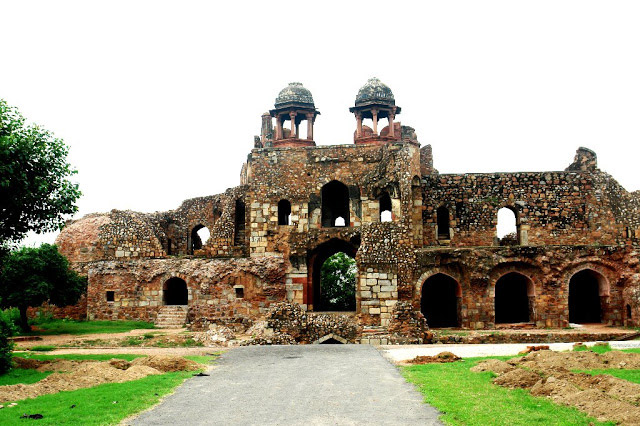
Tughlaqabad
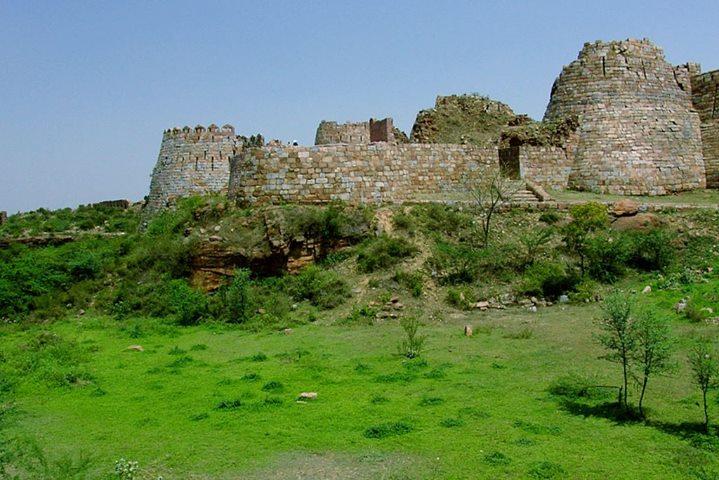
When Ghazi Malik founded the Tughlaq Dynasty in 1321, he built the strongest fort in Delhi at Tughlaqabad, completed with great speed within four years of his rule. It is said that Ghazi Malik, when only a slave to Mubarak Khilji, had suggested this rocky prominence as an ideal site for a fort. The Khilji Sultan laughed and suggested that the slave build a fort there when he became a Sultan. Ghazi Malik as Ghiyasuddin Tughlaq did just that—Tughlaqabad is Delhi/’s most colossal and awesome fort, even in its ruined state. Within its sky-touching walls, double-storied bastions, and gigantic towers were housed grand palaces, splendid mosques, and audience halls.
Muhammad-bin-Tughlaq, who is accused of having murdered his sire, built Adilabad and Nai-ka-Kot—two small fortresses adjacent to Tughlaqabad fort, Adilabad, the fourth fort of Delhi, contained a grand palace of thousand pillars and splendid halls. Later he enclosed the city lying between Siri, Tughlaqabad, and the Qutab and called it Jahanpanah. Ruins of gigantic ramparts of his two fortresses and some portions of the Jahanpanah walls have survived the ravages of time. A small portion of his Jahanpanah watchtower Vijai Mandal still stands in ruins dominating the landscape.
Badhkal Lake
Situated in the Faridabad district of Haryana, the panoramic Badhkal Lake is a natural pool surrounded by vast lawns and lush greenery. Just over 30 km from Delhi, the lake is a popular picnic spot. It also offers boating facilities to tourists.
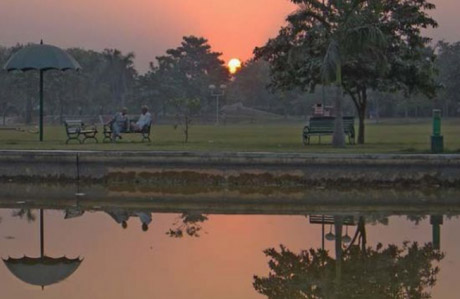
Kesroli
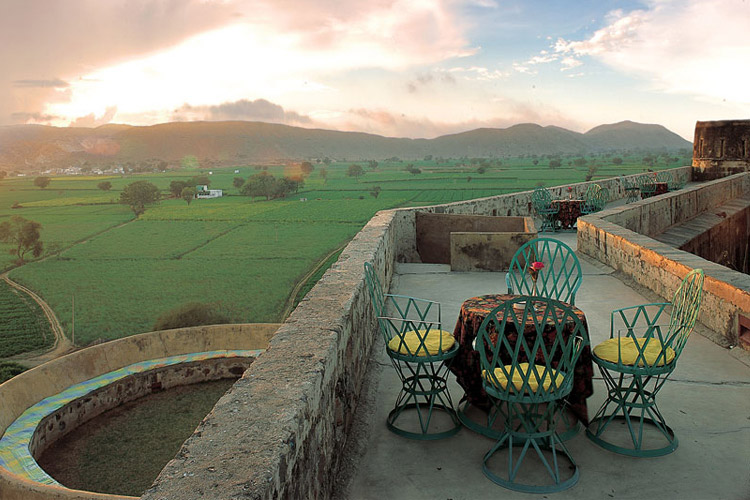
A three-hour drive from Delhi, Kesroli in Rajasthan is the site of a seven-turreted fort built in the 16th century. Believed to have been built by the Yaduvanshi Rajputs, the fort commands splendid views of the surroundings from its ramparts.
Mud Fort
Barely 80 km from the din and bustle of Delhi stands the Mud Fort of Kuchesar, which was built in the mid-18th century by the Jat rulers. The fort has bravely withstood the onslaught of the Marathas, Sikhs, Rohillas, and Rajputs, as well as the French and East India Company. The fort was built with seven turrets so as to withstand the cannons of the British.
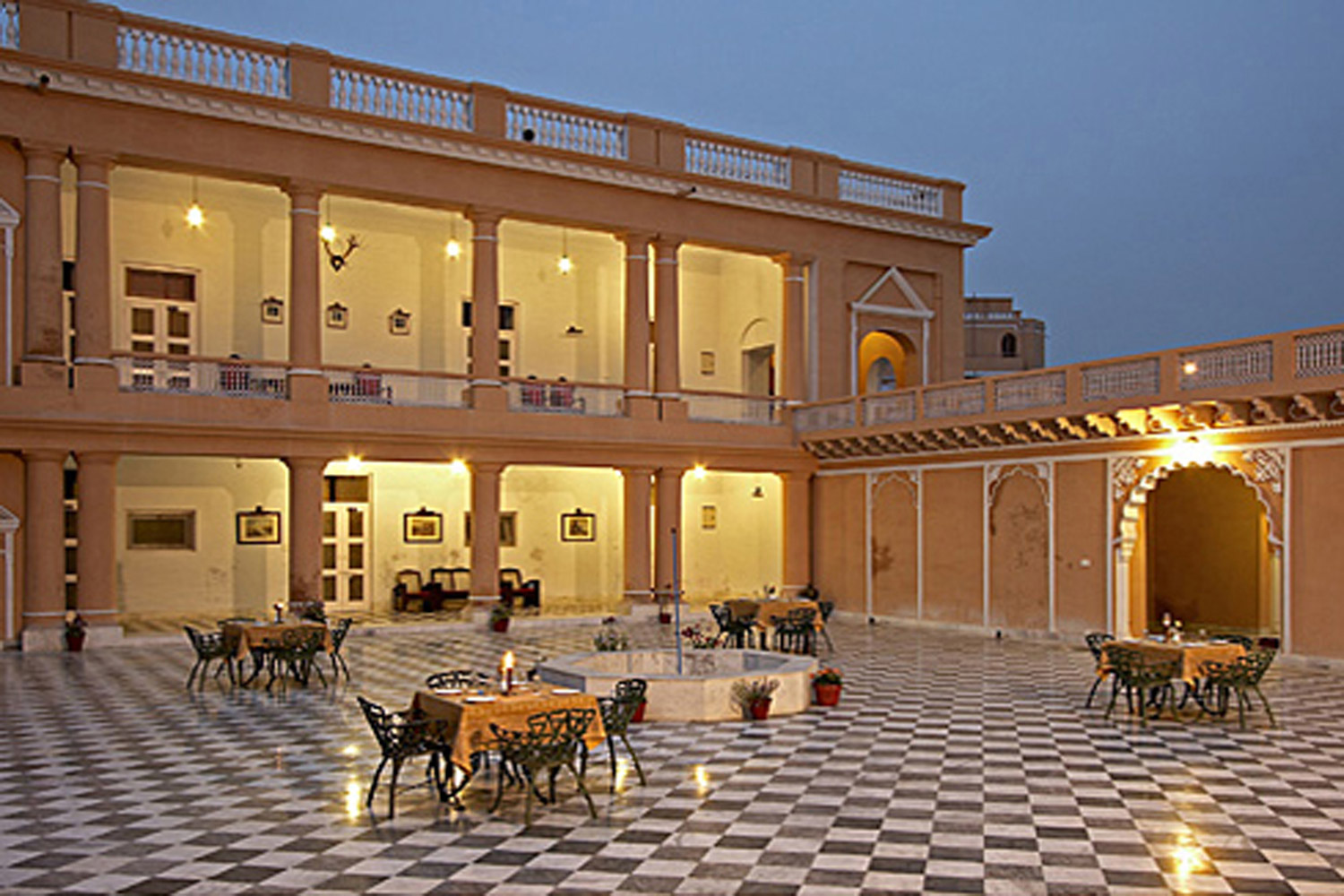
Neemrana
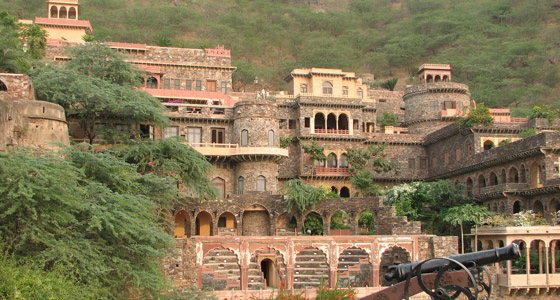
Situated 122 km from Delhi, on a rocky outcrop just above an unspoilt village, lies Neemrana, the site of a majestic fort built in 1464 by Prithviraj Chauhan III. The Neemrana Fort, as it is known, has now been converted into a heritage resort.
Sultanpur
Located 46 km from Delhi, just beyond Gurgaon, Sultanpur is a small bird sanctuary. The jheel (shallow lake) with reeds and other waterside plants growing around it becomes a hub of activity in November-December every year when northern migratory birds arrive here. The jheel is home to the only indigenous Indian crane, sarus.

Surajkund
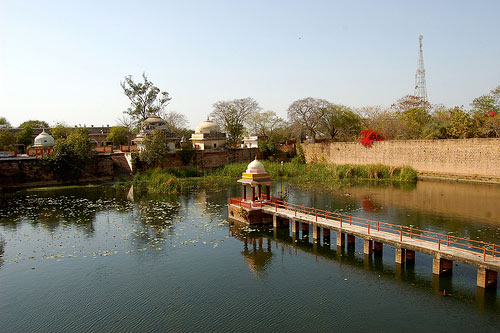
Situated 11 km from the Qutab Minar on the Mehrauli-Badarpur Road, Surajkund is the site of a perennial lake surrounded by rock-cut steps. The Sun temple stood here during AD 1000, the remains of which can still be seen here. The temple and the enchanting surroundings of this place won the heart of a Tomar chieftain Surajpal, who belonged to a clan of sun worshippers. Raja Surajpal had a sun pool and amphitheatre built in this area with the sun temple at its periphery. After the chieftain Surajpal, who built the complex, the place was named Surajkund
It was around this temple and pool that a tourist resort came up in Surajkund. What began as simple tourist centre in 1987 flowered into a celebration of the centuries old crafts traditions of our colourful country at the annual Surajkund Crafts Mela. As spring glides in, full of warmth and vibrancy leaving the grey winter behind, Surajkund adorns itself with colourful traditional crafts of India. Craftsmen from all over the country assemble at Surajkund during the first fortnight of February to participate in the annual celebration known as the Surajkund Crafts Mela. This mela is a meeting ground for talented artists, painters, weavers, sculptors and craftsmen as well as arts and crafts lovers who come from the world over to admire and acquire these creations. The Surajkund Mela is not just the biggest artisans/’ fair in the country; it is also unique in that every year there is a different theme to the fair
Tilyar Lake
Situated 70 km from Delhi in Rohtak district, the Tilayar Lake is a favourite getaway for tourists. The lake offers facilities for boating, accommodation, restaurants, bar, children/’s park and a mini zoo.
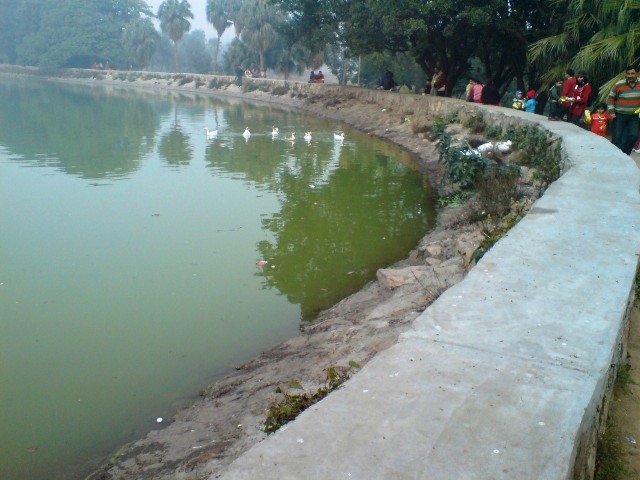
Fact File
 Area: 1,483 sq. km
Area: 1,483 sq. km
 Population:9,420,644 (1991)
Population:9,420,644 (1991)
 Altitude: 216 m above sea level
Altitude: 216 m above sea level
 Best Time to Visit:February–April and August–November
Best Time to Visit:February–April and August–November
 Languages:Hindi, English, Punjabi, & Urdu
Languages:Hindi, English, Punjabi, & Urdu
 STD Code:011
STD Code:011




